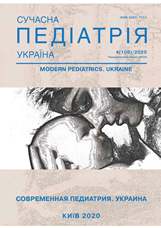Prediction of development of mitral valve insufficiency in children with infectious rheumatic endocarditis
Keywords:
infectious endocarditis, acute rheumatic fever, mitral valve insufficiencyAbstract
Acquired heart defects are a modern medical and social problem, because even in childhood they can lead to chronic heart failure, and in the future — to the development of persistent disability and premature death of adults. In this case, the main causes of acquired heart defects in childhood are acute rheumatic fever (ARF) and infectious endocarditis (IE). In most countries of the world rheumatic heart defects remain the most common cause of deaths from cardiovascular diseases in the age groups under 35 years old, exceeding mortality rates from coronary heart disease and arterial hypertension. Despite the fact that over the past decades the frequency of ARF has sharply decreased, the problem of complications of the disease remains relevant.
Purpose — to develop prognostic tables for the development of mitral valve insufficiency (MVI) in children at the onset of rheumatic fever and in infectious endocarditis at the onset of the disease in order to prevent the adverse course of the disease, acquired heart disease, development of chronic heart failure and disability.
Materials and methods. 57 children were examined, 26 of them with infectious endocarditis with mitral valve insufficiency, 31 with rheumatic endocarditis. The control group included 30 children without mitral valve insufficiency. All children underwent Doppler echocardiography, electrocardiography, general clinical and biochemical analyses.
Results. Based on a sequential Wald analysis and an assessment of the information content of signs according to the calculated Kullback's measure with Yeats' correction, a diagnostic table for predicting mitral valve insufficiency was developed. Diagnostic coefficient and general informational content of clinical, laboratory data, dopplerochocardiographic parameters of valvular hemodynamics and echometric parameters of ultrasonic density of the endocardium, mitral (Mt) valve and its structures were evaluated. It turned out that the highest predictive information content of the development of MVI in children with rheumatic endomyocarditis in acute rheumatic fever had periods of mitral regurgitation and volume of Mt-regurgitation, blowing systolic murmur at the heart apex, ASL-O titer, degree of Mt-regurgitation, index of minute volume of Mt-regurgitation, acute streptococcal infection 2 weeks before the manifestation of rheumatic heart disease in the anamnesis. The most prognostically significant for the development of MVI in IE were the following: systolic murmur of organic origin at the heart apex, the degree of Mt regurgitation, the index of minute volume of Mt-regurgitation, and the increase in the coefficient of ultrasonic density (Cud) of the endocardium of the posterior wall of the left ventricle, the volume of Mt-regurgitation, increased Cud of the anterior cusp of the mitral valve, increased Cud of the posterior cusp of the Mt0valve. The use of the developed prognostic tables with a probability of error of <5% made it possible to predict the development of insufficiency of mitral valve in children with rheumatic endomyocarditis in acute rheumatic fever and in children with infectious endocarditis.
Conclusions. Thus the use of developed diagnostic and prognostic criteria facilitated a complex assessment and definition of clinical, laboratory and echocardiographic signs of inflammatory lesion of the valves, likelihood of development of valve failure in sick children with rheumatic and infectious endocarditis which contributed to increase of quality improvement of primary diagnostics, defining of disease prognosis and enabled to administer adequate individual therapy.
The research was carried out in accordance with the principles of the Helsinki Declaration. The study protocol was approved by the Local Ethics Committee of these Institutes. The informed consent of the patient was obtained for conducting the studies.
References
Beaton А, Okello Е, Lwabi Р, Mondo С et al. (2012). Echocardiography screening for rheumatic heart disease in Ugandan schoolchildren. Circulation. 125 (25): 3127—3132. https://doi.org/10.1161/CIRCULATIONAHA.112.092312; PMid:22626741
Berezhny VV, Marushko TV, Marushko YuV. (2013). Clinical rheumatology of childhood. Kyiv: 266.
Chen X, Sun D, Yang J, Feng W. (2011). Preoperative assessment of mitral valve prolapse and chordae rupture using real time three-dimensional transesophageal echocardiography. Echocardiography. 28 (9): 1003—1010. https://doi.org/10.1111/j.1540-8175.2011.01474.x; PMid:21854426
Chi N-H, Chou N-K, Yu Y-H еt al. (2014). Heart transplantation in end-stage rheumatic heart disease — Experience of an endemic area. Circulation. 78 (8): 1900—1907. https://doi.org/10.1253/circj.CJ-13-1606; PMid:24965078
Dziak GV. (2009). Acute rheumatic fever. Principles of diagnostics and treatment. Modern medical technologies. 1: 59—61.
Honchar MО. (2014). Topical issues of diagnostics and monitoring of cardio-vascular disorders in children after cardiosurgical treatment of congenital heart diseases. Child health. 3: 138—142.
Roldan CA, Qualls CR, Sopko KS, Sibbitt WL. (2008). Transthoracic versus transesophageal echocardiography for detection of Libman-Sacks endocarditis: a randomized controlled study. Rheumatology. 35 (2): 224–229.
Downloads
Published
Issue
Section
License
The policy of the Journal “MODERN PEDIATRICS. UKRAINE” is compatible with the vast majority of funders' of open access and self-archiving policies. The journal provides immediate open access route being convinced that everyone – not only scientists - can benefit from research results, and publishes articles exclusively under open access distribution, with a Creative Commons Attribution-Noncommercial 4.0 international license (СС BY-NC).
Authors transfer the copyright to the Journal “MODERN PEDIATRICS. UKRAINE” when the manuscript is accepted for publication. Authors declare that this manuscript has not been published nor is under simultaneous consideration for publication elsewhere. After publication, the articles become freely available on-line to the public.
Readers have the right to use, distribute, and reproduce articles in any medium, provided the articles and the journal are properly cited.
The use of published materials for commercial purposes is strongly prohibited.

